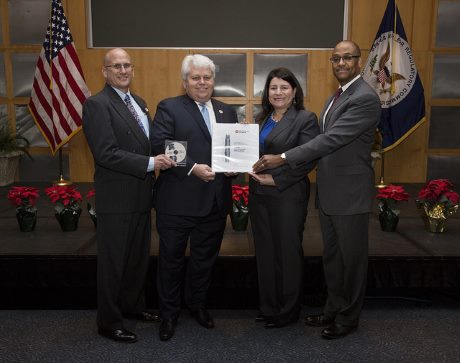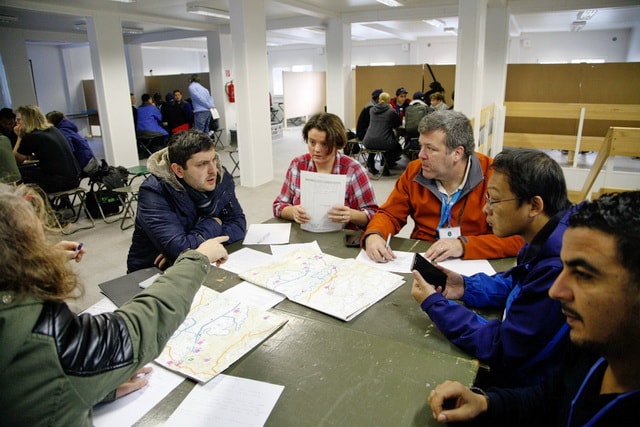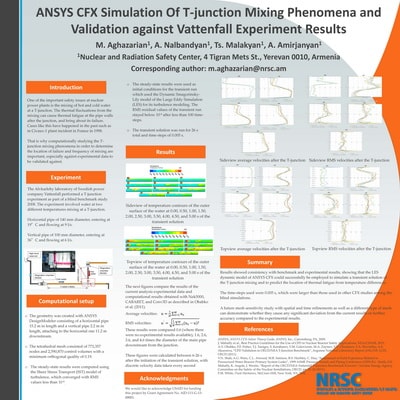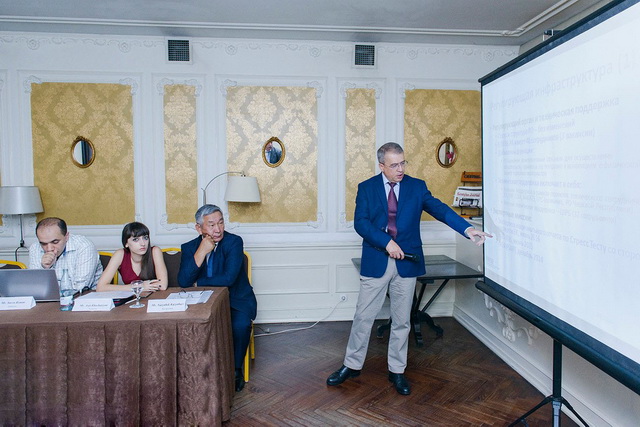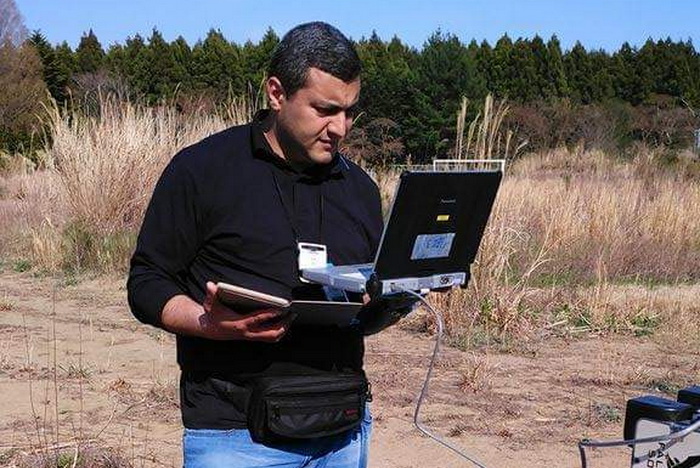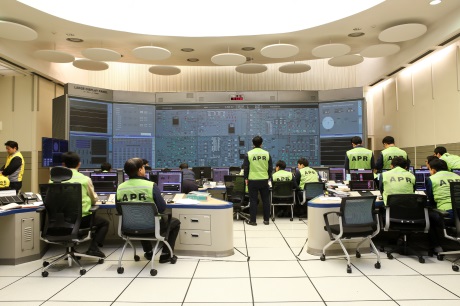NRSC has participated in the workshop devoted to modifications of the nuclear power plants, which was held in the Xiamen, People’s Republic of China from July 10 to 14. Workshop was organized by International Atomic Energy Agency with cooperation with China Nuclear Power Engineering Company. Participants of the workshop discussed the experience of different countries in the field of NPP safety improvement. NRSC specialist Hovhannes Hovhannisyan presented regulatory framework and scientific-technical provisions of the ANPP safety improvement process, particularly role of the Nuclear and Radiation Safety Centre in research and analytical justification of measures significant from point of view of nuclear safety. Was presented NRSC experience of neutron kinetics, thermal-hydraulic, mechanical and radiological calculations during implementation of ANPP technical modifications. Also was presented “Requirements on Nuclear Installation Technical Modifications” which is used in Armenia. Participants had provided an information on implementation of modifications at their countries and discussions were organized on how to make modifications implementation process more efficient. In frame of meeting a visit to Fuqing NPP was organized, where are 4 operating and 2 constructing units.
The four-week fellowship took place at the Brookhaven National Laboratory. The supervisor of the on job training was Dr. Peter Kohut, research scientist at the Nuclear Science and Technology Department. The main purpose of this fellowship was to gain specific knowledge related to application of TRACE code to VVER reactor type plants, and particularly to assess applicability of the TRACE code 3D modeling capabilities to VVER-440 type reactors. Information about fellowship is also presented at the ANL International programs site: https://international.anl.gov/fellows/2017/Hovhannes%20Hovhannisyan%20-%20ARM-16004%20-%202017-02.pdf https://international.anl.gov/fellowships.html
Michael Johnson, NRC deputy executive director for operations (right), and Vonna Ordaz, acting director of the Office of New Reactors (second from right), receive NuScale’s application from NuScale chief nuclear officer Dale Atkinson (second from left) and NuScale vice president for regulatory affairs Tom Bergman (left). (Image: NRC) NuScale Power has asked the US Nuclear Regulatory Commission (NRC) to approve the company’s small modular reactor (SMR) commercial power plant design. This is the first-ever SMR design certification application to be submitted to the NRC. The 31 December submission of the application was commemorated yesterday at NRC headquarters, in the Washington suburbs, by NuScale CEO John Hopkins, co-founder and chief technology officer Jose Reyes, chief nuclear officer Dale Atkinson, and vice president for regulatory affairs Tom Bergman. Atkinson said: “We reached this tremendous milestone through the efforts of more than 800 people over eight years … We have documented, in extensive detail, the design conceived by Dr Jose Reyes more than a decade ago. We are confident that we have submitted a comprehensive and quality application, and we look forward to working with the NRC during its review.” The application consisted of nearly 12,000 pages of technical information and the NRC is expected to take the next two months to determine if any additional information is required prior to commencing their review. The regulator has therefore targeted completing the certification process within 40 months. Once issued, a design certification is valid for 15 years in support of a combined licence application (COLA) to construct and operate a power plant. Demand The Portland, Oregon-based company said that, once approved, global demand for its plants will create thousands of jobs during manufacturing, construction and operation, and “re-establish US global leadership in nuclear technology”, paving the way for NRC approval and subsequent deployment of other advanced nuclear technologies. Conservative estimates predict about 55-75 GWe of global electricity will come from SMRs by 2035, equivalent to over 1000 NuScale Power Modules, it added. The first commercial 12-module NuScale power plant is planned to be built on the site of the Idaho National Laboratory (INL). It will be owned by the Utah Associated Municipal Power Systems (UAMPS) and operated by Energy Northwest. UAMPS CEO Doug Hunter said submission of the design certification application was key to UAMPS project licensing and target commercial operation date of 2026 for the UAMPS Carbon Free Power Project. As the sole winner of the second round of the Department of Energy’s competitively-bid cost-sharing program for SMR technology development, NuScale is the only SMR developer currently receiving DOE financial support. In 2015, DOE awarded NuScale and UAMPS a $16.7 million grant as part of a three-year cooperative agreement to conduct site characterization activities at INL and prepare documentation leading to a COLA for a first plant at INL. NuScale has also launched the Western Initiative for Nuclear, a broad collaboration of six states to study the demonstration and deployment of a series of NuScale SMR power plants in the Western United States. Steve Kuczynski, CEO of Southern Nuclear and chairman of the New Plant Advisory Committee at the Nuclear Energy Institute (NEI), said “At Southern Company, we are building the first new-generation nuclear plants in the United States. We are committed to nuclear energy and we want to have NuScale SMRs as an option.” Historic moment The commemoration event yesterday included a press conference, which five members of Congress, the DOE’s undersecretary for science and energy, and NEI President and CEO Maria Korsnick attended. Korsnick said it was an “historic moment of innovation in the electric sector” in a continuum of developments and innovation in nuclear technology. “The journey starts with preservation of America’s existing nuclear power plants, including second licence renewal to allow today’s plants to operate beyond 60 years. It proceeds through construction of more large light water reactors, like the four being built in Georgia and South Carolina,” she said. “It further includes deployment of small modular light water reactors in the mid-2020s. And finally, development, demonstration and deployment of advanced nonlight-water reactors.” The NuScale SMR consists of integrated pressurized water reactor modules, designed on the light water reactor technology that has safely operated worldwide for the past 70 years. When coupled to its factory fabricated power generation equipment, a NuScale Power Module can produce 50 MW of electricity. A NuScale power plant can house up to 12 of these modules for a total facility output of 600 MW (gross). A power plant’s capacity can be increased in stages depending on electricity demand. Construction timeframes – about 36 months for each module – can make it easier for a smaller utility to raise capital and allow quicker returns on an investment while the rest of the plant is under construction, NEI said. In addition, each module can be built at an off-site factory and shipped to the plant site via truck, train or barge. The NuScale design also has unique safety characteristics: under abnormal conditions, the reactor can shut itself down and cool itself for indefinite periods without the need for human intervention, water addition or external electricity supplies. NuScale has been working on its SMR design for more than ten years, with initial development and testing at Oregon State University. In 2011, the global engineering, procurement and construction firm Fluor Corp became the majority investor in NuScale. Scott Burnell, public affairs officer at the NRC, said NuScale’s application is the first to propose a nuclear power plant designed with several small reactors instead of one large one. “The company has discussed this approach with us since 2008, using much the same ‘pre-application’ process followed by makers of traditional large reactors. These talks helped both the NRC and NuScale understand where the design might need additional supporting information or alternative approaches to NRC policies. For instance, NuScale examined how its design could best meet the NRC’s requirements for staff in the control room,” Burnell said. The NRC also used information from NuScale in developing a design-specific review standard.
NRSC specialist Vahagn Petrosyan has participated in the Third On-Site Inspection Training Cycle Introductory Course (IC-3TC) organized by the CTBTO. The training course was held from 15 to 29 October 2016 in Zvolen, Slovakia. The 80 participants represented more than 50 Countries. During the training course, have been considered procedures, time frames of the Inspections and responsibilities and rights of the Inspectors Team in a case of possible nuclear test explosion. The second part of the training course has been conducted in the Special Forces Training Facility Lest, where the main possible indicators of nuclear test explosion have been investigated during the field exercises.
NRSC specialists Hovhannes Hovhannisyan and Mher Mantashyan participated in the ANSYS CFX advanced training course which took place at the Budapest University of Technology and Economics on 3-28 October 2016. The training course was organized within the support of Brookhaven National Laboratory (in the framework of US NRC and ANRA cooperation agreement) and was aimed to provide deep knowledge in the field of ANSYS CFX code. In the framework of training NRSC specialists modeled WWER-440 reactor’s pressure vessel and fuel assembly. Using developed models were performed calculations.
The NRSC mobile response group participated in the emergency response exercise at Bavra checkpoint of the Armenian-Georgian border from 26 to 29 September 2016. The exercise was organized by the embassy of United States in Armenia. During the exercise, the NRSC experts have conducted the identification of radioactive sources, localization of contaminated areas and objects.
NRSC participated in the Computational Fluid Dynamics for Nuclear Reactor Safety 6 (CFD4NRS-6) workshop held in MIT, Cambridge from September 13-15, 2016. The workshop is organized by OECD and NEA and the theme of the last one was uncertainty analysis of computational fluid dynamic applications related to nuclear safety. NRSC simulation of a T-junction mixing problem was presented as a poster titled ANSYS CFX Simulation of T-junction Mixing Phenomena and Validation against Vattenfall Experiment Results. See Poster
The U.S. NRC organized the sixth workshop on Radiation Sources Regulatory Partnership program. The workshop was held from 5 to 7 September in Tbilisi, Georgia. Participants represented the following countries – Armenia, Azerbaijan, Czech Republic, Georgia, Lithuania, Kyrgyzstan, Moldova, Tajikistan, Ukraine, Uzbekistan. Representatives from AdSTM/Qi Tech and U.S. NRC have attended the meeting. Participants presented the status of finished and current work and accomplishments in improving state control of radiation sources and X-ray devices during the past years within the U.S. NRC assistance program and outside of the program. During the meeting, NRSC presented the new features of ARIS v2.2 and NUCMAT v3.1, how to install and uninstall the new version of the software and how to restore the database from older versions. All new features have been demonstrated to the participants. In the workshop program was included also the presentation about the upcoming version of ARIS (v2.5). New features planned to implement in the next version of the software were presented. The new support websites of ARIS and NUCMAT also were demonstrated. All suggestions, comments and requests from participants were discussed and recorded to promote onwards software improvements and to make software more comfortable and useful for all users.
The IAEA organized a workshop held in Koriyama, Japan, 16-20 April 2016 on radiation monitoring during the nuclear emergencies. The NRSC expert participated in radiation monitoring activities on high-contaminated areas of Fukushima site. Workshop participants from 7 countries performed in-situ–gamma ray-spectrometry, dose rate measurements and sampling of contaminated soil.
Unit 3 of South Korea’s Shin Kori nuclear power plant was connected to the grid on 15 January and has started supplying electricity, plant owner Korea Hydro and Nuclear Power (KHNP) announced yesterday. Shin Kori 3 – construction of which began in October 2008 – is the first Korean-designed Advanced Pressurised Reactor-1400 (APR-1400) to start up. Having been issued with an operating licence for the unit by the Nuclear Safety and Security Commission on 30 October, KHNP began loading 241 fuel assemblies into the reactor on 4 November. The unit achieved first criticality on 29 December. KHNP has since been conducting commissioning tests at the unit. These tests involve checking the unit’s performance as its output is gradually increased to full capacity. Shin Kori 3 is expected to enter commercial operation in May following the completion of these tests, KHNP said. It becomes South Korea’s 25th operable power reactor. Unit 4 at Shin Kori – also an APR-1400 – is expected to start operating in early 2017. Unit 3 had originally been due to begin operating at the end of 2013, with unit 4 following in September 2014. However, their operation has been delayed by the need to test safety-related control cabling and its subsequent replacement. Two more of the 1350 MWe pressurized water reactors are under construction as units 1 and 2 of the Shin Hanul site in South Korea. Those units are expected to enter service in April 2017 and February 2018, respectively. Two further APR-1400 units are planned for both the Shin Kori and Shin Hanul sites. Four more APR-1400s are under construction at Barakah in the United Arab Emirates. All four are scheduled to be in operation by 2020. Researched and written by World Nuclear News



